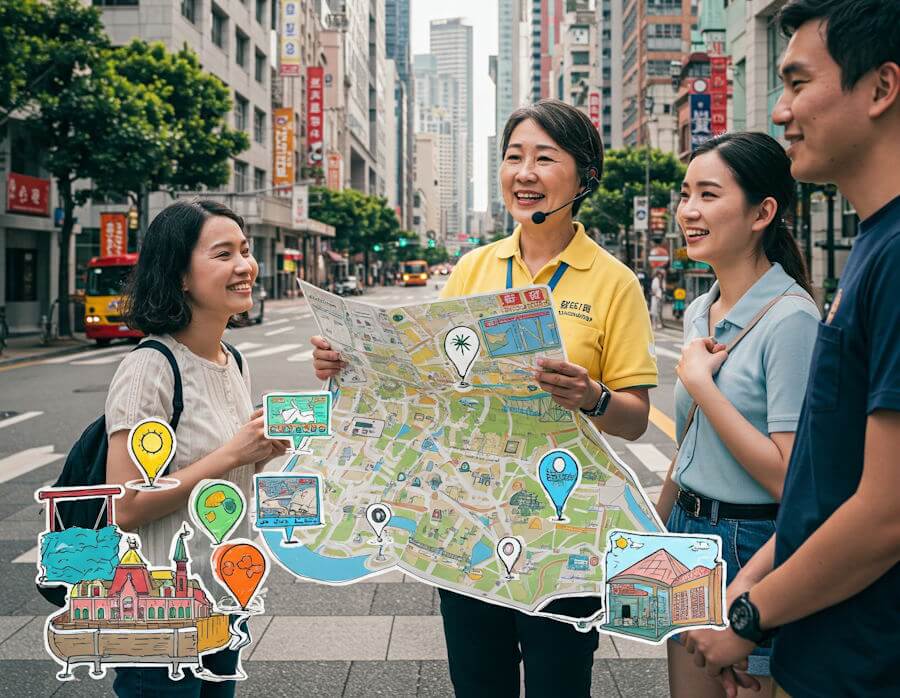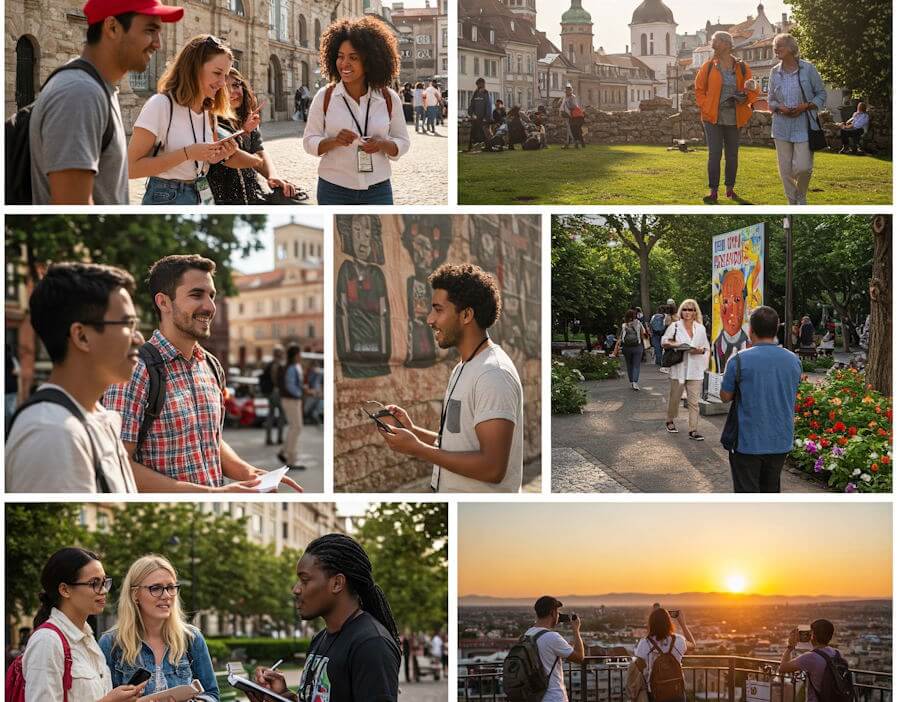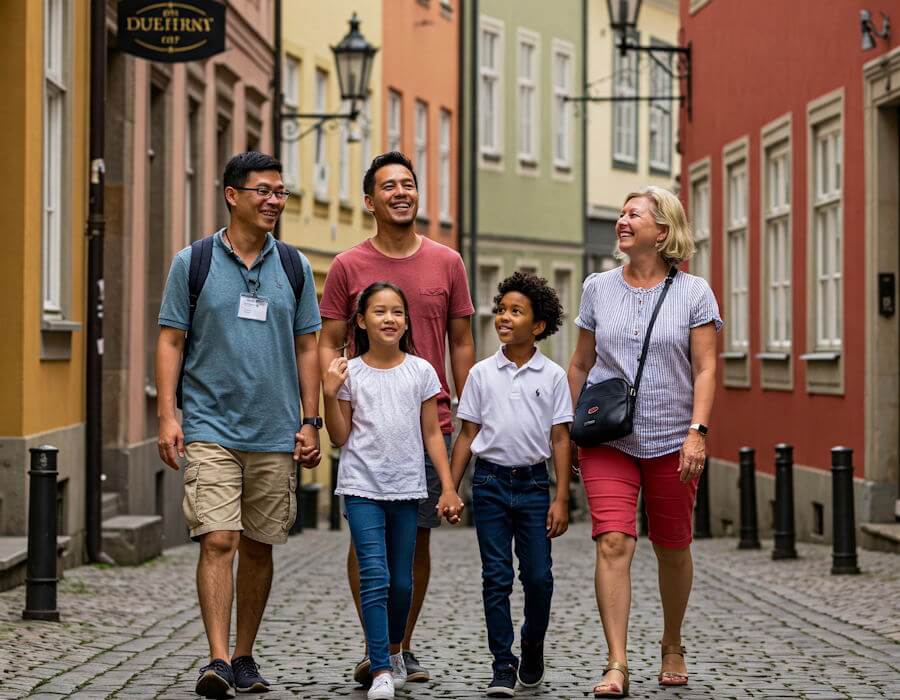Introduction to Interactive City Tours
Interactive city tours represent a modern evolution in travel experiences, integrating technology and engagement to transform the traditional sightseeing approach. These tours encourage visitors to not only observe but actively participate in the exploration of a city, allowing for a more profound connection to the culture, history, and people. This shift towards interactivity is fueled by advancements in mobile technology, augmented reality, and an increasing desire for personalized experiences among travelers.
One of the primary reasons for the growing popularity of interactive city tours is the enhancement of engagement they offer. Unlike conventional tours, which often rely on a one-sided lecture format, interactive experiences invite tourists to become active participants. Visitors can engage with the environment through mobile applications that guide them to locations of interest, providing historical context, trivia, and visualizations that bring stories to life. Such interactivity not only sustains attention but also promotes a deeper understanding of the sites being visited.
Another significant advantage is the improvement in learning experiences. The incorporation of interactive elements caters to various learning styles, whether visual, auditory, or kinesthetic. For instance, augmented reality features allow tourists to see historical figures or events unfold in real-time, creating a vivid backdrop that captivates the imagination. This immersive learning fosters retention and helps travelers to appreciate the significance of their surroundings, thus turning a simple tour into a meaningful journey.
Moreover, interactive city tours provide a memorable adventure for tourists. By enabling personal participation, individuals can customize their experiences based on interests and preferences. Whether it’s scavenger hunts, interactive storytelling, or engaging with local communities, these tours foster unique memories that resonate long after the trip concludes. As a result, many travelers are increasingly seeking out these innovative experiences to enhance their city exploration.
Understanding Your Audience’s Preferences
When planning an engaging city tour that incorporates interactive elements, it is crucial to understand your audience’s preferences thoroughly. This knowledge enables tour organizers to tailor experiences that are not only enjoyable but also resonate with participants on a personal level. Gathering insights about your audience can be achieved through various methods, including surveys, polls, and social media interactions. These tools provide valuable demographic information and insights into interests or activities that potential participants may enjoy.
Demographics play a significant role in shaping the tour experience. Factors such as age, cultural background, and travel experience can influence the types of interactive elements that will be most appealing. For instance, younger audiences might prefer more technologically advanced activities, such as augmented reality experiences, whereas older participants may be more inclined towards traditional storytelling or hands-on experiences that connect them to the city’s history. Noticing these trends can accentuate the effectiveness of the tour, making the content relevant and engaging.
Additionally, understanding interests can guide the selection of thematic elements incorporated into the city tour. By analyzing popular attractions or interactive experiences that have received positive feedback in the past, planners can curate activities that align with the preferences of their target demographic. For example, a food tour may benefit from involving local chefs offering cooking demonstrations or tasting sessions if interested attendees show a keen interest in culinary experiences.
Ultimately, comprehensive audience insights empower tour organizers to craft a more dynamic experience that connects with participants, enhancing the overall quality of the tour. By prioritizing the needs and desires of the audience, it becomes possible to create memorable, interactive experiences that leave a lasting impression on everyone involved.
Types of Interactive Elements to Consider
In modern city tours, incorporating interactive elements can significantly enhance the overall experience for participants. These elements not only encourage engagement but also foster a deeper connection to the surrounding environment. One effective method to achieve this is through gamification, which can include activities such as scavenger hunts and quizzes. These games require participants to solve clues, explore various landmarks, and interact with fellow tour-goers, thus turning a standard tour into an exciting adventure.
In addition to gamification, technology plays a crucial role in enhancing city tours. Mobile applications can serve as valuable tools, providing real-time information, historical context, and multimedia content related to specific sites. Many apps also feature interactive maps, allowing participants to navigate the city effortlessly. Furthermore, the integration of augmented reality can superimpose digital information onto real-world environments, offering a unique perspective on historical landmarks and facilitating immersive learning experiences.
Participatory experiences represent another vital type of interactive element that can transform city tours. Street performances, for example, not only entertain but can also educate participants about local culture and traditions. Engaging with artists or local performers fosters a connection between tourists and the community, enriching the cultural aspect of the tour. Workshops, where participants can learn crafts or cooking techniques from local artisans, also provide hands-on experiences that enrich the narrative of a city’s history and its people.
Incorporating these interactive elements into city tours is pivotal in creating memorable experiences. By utilizing gamification strategies, technology enhancements, and participatory activities, tour providers can offer a much more engaging and comprehensive exploration of the city, promoting both education and enjoyment. These elements not only elevate the tour experience but also stimulate a deeper appreciation for the destinations being explored.
Incorporating Technology for Engagement
In recent years, the integration of technology into city tours has revolutionized the way visitors experience urban environments. Using technologically advanced tools, tour operators can create interactive experiences that enhance engagement and provide deeper insights into the city’s unique historical and cultural narratives. One of the most significant developments in this area is the use of virtual reality (VR) headsets. With the ability to transport users to various historic events or locations, VR can offer an immersive experience that traditional tours cannot achieve. For instance, a VR experience can allow tourists to witness the city’s past, such as significant landmarks during pivotal moments in history, making their visit both educational and entertaining.
Moreover, mobile applications have become indispensable in facilitating user interaction during city tours. These apps can provide users with real-time information about landmarks, suggesting personalized routes based on user interests. Features like augmented reality (AR) can be integrated, allowing tourists to point their devices at historical sites and receive additional contextual information displayed on their screen. Such interactive elements not only keep users engaged but also promote self-directed learning, thus enhancing the overall tour experience.
Interactive maps are another effective tool in promoting engagement during a city tour. By utilizing GPS technology, these maps can guide tourists through their journey while offering essential details about nearby attractions, restaurants, and events. Users can click on various points of interest to receive detailed audio or visual descriptions, creating a dynamic flow of information tailored to their interests. This allows for a more personalized exploration of the city, catered to individual preferences. Through leveraging these technological tools, tour operators can significantly elevate the level of interaction and engagement on their city tours, fostering a deeper connection between the tourists and the urban environment.
Creating Your Interactive Itinerary
Designing an interactive itinerary is essential for delivering a unique and engaging city tour experience. To begin, one must strategically blend traditional tourist attractions with interactive elements. This could involve incorporating historical reenactments, guided storytelling sessions, or hands-on workshops that allow visitors to immerse themselves in the local culture. When creating the itinerary, it’s crucial to identify key landmarks and events that resonate with the overall narrative of the tour, ensuring that all elements complement each other harmoniously.
As you outline your itinerary, set a realistic timeline for each activity. Allocate sufficient time for both interactive components and traditional sightseeing to avoid overwhelming participants. Consider the logistics involved, including travel time between locations, the duration of interactive activities, and potential wait times at popular attractions. A well-structured timeline will facilitate a seamless flow throughout the tour while ensuring that guests can comfortably enjoy each experience.
Furthermore, it’s important to select interactive features that appeal to a broad audience. This might mean offering a variety of experiences that cater to different preferences, such as technology-driven experiences like augmented reality displays, or creative activities like local crafts workshops. In doing so, you enhance participant engagement and foster a more memorable experience. Moreover, utilizing feedback from previous tour-goers can help identify which interactive elements have resonated best, allowing for continual improvement of the itinerary.
Ultimately, your interactive itinerary should narratively weave together the traditional and interactive aspects of the tour while maintaining a clear and captivating storyline. By thoughtfully planning the elements and ensuring their cohesiveness, you will not only enhance the appeal of your city tour but also create lasting memories for participants.
Safety Considerations for Interactive Activities
When planning a city tour that incorporates interactive elements, it is paramount to prioritize the safety of participants. Engaging activities, whether they involve physical challenges or technological integrations, must be designed with a strong focus on the well-being of all participants. This commitment to safety not only protects individuals but also enhances the overall experience, fostering an enjoyable and memorable environment.
Firstly, assessing the physical demands of any activity is essential. Ensuring that participants are physically capable of engaging in specific challenges is crucial. This can involve providing clear information about the activity levels required, allowing guests to make informed decisions about their participation. Implementing safety measures such as clear signage, adequate spacing, and supervision can help minimize risks associated with physical activities. Regularly reviewing participant health assessments can further ensure that safety protocols are met.
Secondly, when utilizing technology as part of the interactive experience, it is essential to adhere to established guidelines. Proper instruction on how to use provided devices or software enhances safety. For instance, informing participants about the correct use of augmented reality glasses or mobile apps can prevent accidents and technical issues. Moreover, using robust, user-friendly technology reduces the chances of malfunctions that could lead to unsafe situations.
Lastly, effective crowd control measures are indispensable during interactive experiences to ensure the smooth and safe flow of participants. Designating staff to manage large groups, directing foot traffic, and maintaining open lines of communication can significantly mitigate potential hazards. Additionally, setting boundaries for certain activities and ensuring that emergency procedures are clear can further heighten safety during city tours enriched with interactive elements.
In conclusion, integrating safety considerations into the planning of interactive activities plays a vital role in enhancing the overall city tour experience. By prioritizing the safety of participants, organizers can foster an engaging and enjoyable atmosphere for all.
Testing Your Interactive Elements
Before officially launching your city tour, it is essential to rigorously test all interactive components integrated into the experience. This evaluation process ensures that each element not only functions correctly but also enhances the overall enjoyment and educational value of the tour. One effective method for testing is to conduct pilot tours with a select group of participants who can provide valuable insights and feedback.
When organizing a pilot tour, carefully choose a diverse group of testers that represents your target audience. This may include locals and tourists of varying ages and backgrounds. During the tour, observe how participants interact with the interactive elements, taking note of their reactions and any difficulties they may encounter. It is also beneficial to encourage open communication, allowing testers to share their thoughts and suggestions actively after the experience concludes.
Gathering feedback is a crucial part of this process. Prepare surveys or conduct informal interviews to collect detailed opinions on specific interactive components. Participants might offer insights on areas that are confusing or suggest features that could enhance their engagement with the tour. Additionally, consider incorporating technology that tracks user interactions; this data can be invaluable in understanding how people navigate through the interactive features you have implemented.
After analyzing the feedback, make necessary adjustments to improve the experience. This iterative approach will not only help in refining the interactive elements but also optimize their functionality. Pay close attention to any recurring themes or concerns raised by testers. By prioritizing user experience during this testing phase, you ensure that the interactive elements are not just operational but genuinely add value to your city tour, making it a memorable experience for all participants.
Marketing Your Interactive Tours
Effectively marketing your interactive city tours is essential for attracting an audience that values unique travel experiences. As travelers increasingly seek immersive adventures, leveraging social media platforms can be a powerful strategy. Engaging content, such as vibrant photos, videos, and testimonials, can showcase the interactive elements of your tours and generate interest. Utilize platforms like Instagram, Facebook, and TikTok to reach diverse demographics, employing targeted ads to focus on specific age groups or interests that align with the essence of your tours.
Creating engaging promotional materials is also vital in gaining attention. Brochures, flyers, and posters should clearly communicate the uniqueness of your interactive city tours, outlining what sets them apart from traditional sightseeing options. Consider including QR codes that direct potential customers to your website or social media channels for more information. Additionally, consider collaborating with local influencers or travel bloggers who resonate with your target audience. They can provide authenticity to your marketing efforts and expand your reach through their established follower base.
Utilizing online platforms is another effective means of promotion. In addition to having an informative and visually appealing website, listing your tours on popular travel websites and platforms such as TripAdvisor or Viator can enhance visibility. Ensure your online presence is optimized for search engines by integrating keywords related to interactive tours and the destinations involved. This will enhance your chances of being discovered by potential customers who are seeking memorable experiences during their travels.
In conclusion, an effective marketing strategy for interactive city tours involves utilizing social media, creating captivating promotional materials, and maximizing online platforms. By integrating these methods, you position your tours to attract the attention of curious travelers seeking unique, engaging adventures in the cities they explore.
Conclusion and Future Trends in City Tours
As we conclude our exploration of enhancing city tours through interactive elements, it becomes apparent that the integration of engagement strategies is vital for modern urban exploration. The key points discussed throughout this blog post highlight the necessity for tour operators to evolve with the shifting preferences of audiences. By harnessing immersive technology, personalization, and collaboration, tour experiences can transcend traditional sightseeing.
The future of city tours is poised to be shaped by an increasingly personalized approach, where visitors can tailor their experiences to meet their individual interests and needs. This shift toward customization allows for enriched interactions, where stories shared by local guides resonate more deeply with participants. Innovation in this space may also drive an enhanced focus on sustainability, helping to protect the cultural and environmental resources of urban landscapes for future generations.
Moreover, the continuous rise of digital experiences will further revolutionize city tours. With the advancement of augmented reality, mobile applications, and virtual reality, tourists can expect to engage with their surroundings in ways that were previously unimaginable. Such technology not only provides enhanced educational value but also encourages tourists to interact more meaningfully with their city’s history and culture.
To stay relevant and attract a diverse audience, city tour operators will need to remain agile and innovative. Adapting to the preferences of different demographic groups, such as Millennials and Gen Z, who seek unique and interactive experiences, is crucial for reaching and engaging these younger travelers. Anticipating trends and embracing cutting-edge technology will empower city tours to remain a vibrant and relevant part of the travel landscape.




